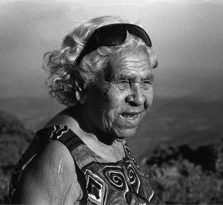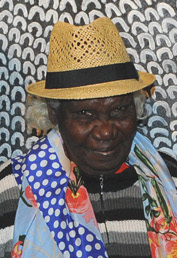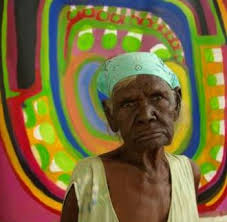Related Research Articles

Queenie McKenzie (Nakarra) was an Aboriginal Australian artist. She was born on Old Texas Station, on the western bank of the Ord River in the East Kimberley.

Ben Quilty is an Australian artist and social commentator, who has won a series of painting prizes: the 2014 Prudential Eye Award, 2011 Archibald Prize, and 2009 Doug Moran National Portrait Prize. He has been described as one of Australia's most famous living artists.
Kathleen Petyarre was an Australian Aboriginal artist. Her art refers directly to her country and her Dreamings. Petyarre's paintings have occasionally been compared to the works of American Abstract Expressionists Jackson Pollock and Mark Rothko, and even to those of J.M.W. Turner. She has won several awards and is considered one of the "most collectable artists in Australia". Her works are in great demand at auctions. Petyarre died on 24 November 2018, in Alice Springs, Australia.
Paddy Bedford, aka "Goowoomji", was a contemporary Indigenous Australian artist from Warmun in the Kimberley, and one of eight Australian artists selected for an architectural commission for the Musée du quai Branly.

Makinti Napanangka was a Pintupi-speaking Indigenous Australian artist from Australia's Western Desert region. She was referred to posthumously as Kumentje. The term Kumentje was used instead of her personal name as it is customary among many indigenous communities not to refer to deceased people by their original given names for some time after their deaths. She lived in the communities of Haasts Bluff, Papunya, and later at Kintore, about 50 kilometres (31 mi) north-east of the Lake MacDonald region where she was born, on the border of the Northern Territory and Western Australia.
Linda Yunkata Syddick Napaltjarri is a Pintupi- and Pitjantjatjara- speaking Indigenous artist from Australia's Western Desert region. Her father was killed when she was young; her mother later married Shorty Lungkarta Tjungarrayi, an artist whose work was a significant influence on Linda Syddick's painting.
Ngoia Pollard Napaltjarri is a Walpiri-speaking Indigenous artist from Australia's Western Desert region. Ngoia Pollard married Jack Tjampitjinpa, who became an artist working with the Papunya Tula company, and they had five children.
Contemporary Indigenous Australian art is the modern art work produced by Indigenous Australians, that is, Aboriginal Australians and Torres Strait Islander people. It is generally regarded as beginning in 1971 with a painting movement that started at Papunya, northwest of Alice Springs, Northern Territory, involving Aboriginal artists such as Clifford Possum Tjapaltjarri and Kaapa Tjampitjinpa, and facilitated by white Australian teacher and art worker Geoffrey Bardon. The movement spawned widespread interest across rural and remote Aboriginal Australia in creating art, while contemporary Indigenous art of a different nature also emerged in urban centres; together they have become central to Australian art. Indigenous art centres have fostered the emergence of the contemporary art movement, and as of 2010 were estimated to represent over 5000 artists, mostly in Australia's north and west.
Shirley Purdie is a contemporary Indigenous Australian artist, notable for winning the 2007 Blake Prize for Religious Art. She is a painter at Warmun Community, in Western Australia's Kimberley region.
Warmun Community and Warmun are a township and locality in the Kimberley region of Western Australia, located on the Great Northern Highway, 3,000 kilometres (1,900 mi) northeast of Perth. The closest populated town is Halls Creek, about 160 km (99 mi) to the south. It is about 200 km (120 mi) south of Kununurra.

Lena Nyadbi is a contemporary Indigenous Australian artist from the Warmun Community in the Kimberley region of Western Australia. Her works include Dayiwul Lirlmim, details of which were painted on the roof of the Musée du quai Branly in Paris. The resulting installation can only be seen from the air, including the Eiffel Tower and Google Earth.
Tiger Palpatja was an Australian Aboriginal artist from the Aṉangu Pitjantjatjara Yankunytjatjara Lands.
Yvonne Koolmatrie is an Australian artist and weaver of the Ngarrindjeri people, working in South Australia.
Vincent Namatjira is an Aboriginal Australian artist living in Indulkana, in the Anangu Pitjantjatjara Yankunytjatjara in South Australia. He has won many art awards, and after being nominated for the Archibald Prize several times, he became the first Aboriginal person to win it in 2020. He is the great-grandson of the Arrente watercolour artist Albert Namatjira.
Kaylene Whiskey, is a Pitjantjatjara artist from Indulkana, a remote Aboriginal community, in South Australia. Whiskey is a contemporary Aboriginal artist who is exhibited in many important Australian galleries and won the 2018 Sir John Sulman Prize at the Art Gallery of New South Wales; she was also a finalist for the 2020 Archibald Prize.

Jukuja Dolly Snell was an artist from Western Australia, who won the 2015 Telstra National Aboriginal and Torres Strait Islander Art Award.
Barbara Mbitjana Moore is an Anmatyerre woman who grew up in Ti-Tree in the Northern Territory, moving later to Amata in South Australia's Anangu Pitjantjatjara Yankunytjatjara (APY) Lands. In April 2003, Moore began painting at Amata's Tjala Arts, and, since then, has received widespread recognition. Moore won a National Aboriginal & Torres Strait Islander Art Award in 2012 and has been a finalist in many other years. Moore has also been a finalist for the Wynne Prize.
Nyapanyapa Yunupingu was an Australian Yolngu painter and printmaker who lived and worked in the community at Yirrkala, Arnhem Land, in the Northern Territory. Yunupingu created works of art that drastically diverge from the customs of the Yolngu people and made waves within the art world as a result. Due to this departure from tradition within her oeuvre, Yunupingu's work had varying receptions from within her community and the broader art world.

Nonggirrnga Marawili is an Australian Yolngu painter and printmaker. She is the daughter of the acclaimed artist and pre-contact warrior Mundukul. Marawili was born on the beach at Darrpirra, near Djarrakpi, as a member of the Madarrpa clan. She grew up in both Yilpara and Yirrkala in Arnhem Land in the Northern Territory, but lived wakir', meaning her family would move frequently, camping at Madarrpa clan-related sites between Blue Mud Bay and Groote Eylandt. As of May 2020 she lives and works in the community at Yirrkala.
Mirdidingkingathi Juwarnda Sally Gabori was an Aboriginal Australian artist who at age 81 began painting in an abstract-like style she developed to represent her Country, on the south side of Bentinck Island in Queensland, Australia.
References
- 1 2 "Garnkiny Ngarrangkarni, (2006) by Mabel Juli". www.artgallery.nsw.gov.au. Retrieved 7 March 2020.
- 1 2 "Mabel Juli". Harvey Art Projects. Retrieved 14 April 2020.
- 1 2 "Mabel Juli". Warmun Art Centre. Retrieved 7 March 2020.
- ↑ "Mabel Juli biography". Short St Gallery. Retrieved 7 March 2020.
- ↑ Art Gallery of New South Wales. [Art Gallery of New South Wales : Australian Gallery File]. OCLC 271079158.
- ↑ Jorgensen, Darren (2016). "Warmun Landscape Painting and the Ngarranggarniny of Mabel Juli" (PDF). Desert River Sea: Kimberley Art, then and Now.
- 1 2 "Mabel Juli | MCA Australia". www.mca.com.au. Retrieved 7 March 2020.
- ↑ "The inspiration of the Telstra NATSIAA 2018 finalists". Telstra Exchange. 7 May 2018. Retrieved 7 March 2020.
- ↑ "For the Next 365 Days, Animations by First Nation Artists Will Light Up the Opera House". Broadsheet. Retrieved 7 March 2020.
- ↑ Whitford, Maddie (13 April 2020). "Producers reflect on profound experience walking with Indigenous artists on country". ABC News. Retrieved 14 April 2020.
- ↑ "This Place: Artist Series". ABC iview. 6 March 2018. Retrieved 14 April 2020.
- ↑ "Know My Name: Overview". National Galley of Australia. Retrieved 14 April 2020.
- ↑ "Know My Name: National Art Event". National Galley of Australia. Retrieved 14 April 2020.